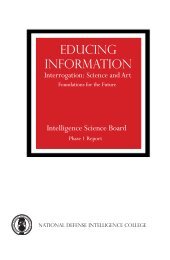COURTING A RELUCTANT ALLY - National Intelligence University
COURTING A RELUCTANT ALLY - National Intelligence University
COURTING A RELUCTANT ALLY - National Intelligence University
- No tags were found...
Create successful ePaper yourself
Turn your PDF publications into a flip-book with our unique Google optimized e-Paper software.
assuaged British concerns about the publicity surrounding Ingersoll’s mission,since they feared an anti-British backlash in America if the true nature of Ingersoll’svisit were discovered. 108Ingersoll arrived in London on 31 December 1937 and linked up with the U.S.Naval Attaché, Captain Russell Willson, who would accompany him during thestaff talks with the British. On 1 January 1938, Ingersoll met with Eden and withthe Deputy Chief of the Admiralty Naval Staff, VADM James. Ingersoll made itclear to all concerned that he was unable to negotiate a formal agreement betweenthe two governments and his mission was “to obtain naval information on whichto plan and to base decisions, if necessary, for future action.” 109 On 3 January,Ingersoll met with ADM Chatfield and his opposite number on the Admiraltystaff, CAPT Phillips. After some general discussions on the strategic nature of thesituation in the Far East, the British very frankly laid out the strategic situation forIngersoll, providing him with detailed information on the size and composition ofthe force they could send to the Far East, the disposition of the forces they hadthere, and the status of Singapore. Realizing how important the exchange ofinformation would be for any coordinated actions, Chatfield told Ingersoll that itwas “desirable to arrange early the means of communication and the exchange ofintelligence between the two fleets.” 110 To this end, Ingersoll discussed with Phillipsthe need for a set of codes that could be used to conduct these informationexchanges. Furthermore, he recommended expanding intelligence exchangeswith the British, stating thatexchange of information by informal agreement is now taking placebetween the British Director of Naval <strong>Intelligence</strong> and Willson regardingJapanese naval construction and the Mandated Islands. The Britishbelieve this should be extended now to include movements and locationof Japan’s naval units. 111While this type of operational intelligence exchange may have already beenoccurring on a limited basis between the U.S. Asiatic Fleet and the BritishChina Fleet, the offer to begin formalizing some of these intelligence108Royal Ingersoll, CAPT, USN, Letter to Captain Russell Willson, USN, 21 February 1938, inthe U.S. Naval Academy Library microfilm collection, Strategic Planning in the U.S. Navy: Its Evolutionand Execution 1891-1945 (Wilmington, DE: Scholarly Resources, Inc., 1979). Collectioncited hereafter as Strategic Planning.109 Royal Ingersoll, CAPT, USN, Memorandum for the Chief of Naval Operations, 31 December1937, Strategic Planning, 1-2.110 Royal Ingersoll, CAPT, USN, Memorandum for the Chief of Naval Operations, 3 January1938, Strategic Planning, 1-2.111 Royal Ingersoll, CAPT, USN, Memorandum for the Chief of Naval Operations, 3 January1938, Strategic Planning, 1-4.32
















